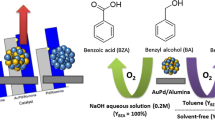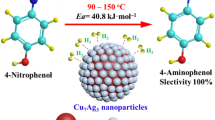Abstract
This paper is devoted to preparation of gold–copper bimetallic nanoparticles deposited on inorganic supporters followed by their use in hydrogen peroxide decomposition and oxidation of ethylbenzene. The bimetallic nanoparticles of Au–Cu at molar ratio of 1:1 were synthesized by hydrothermal method in the presence of stabilizing agent—poly (N-vinyl-2-pyrrolidone) and reducing agent—glycine. The bimetallic nanoparticles were characterized by UV–Vis spectroscopy, DLS, and TEM techniques. The catalytic activity of Au–Cu bimetallic nanoparticles was evaluated with respect to decomposition of hydrogen peroxide and oxidation of ethylbenzene.
Similar content being viewed by others
Explore related subjects
Discover the latest articles, news and stories from top researchers in related subjects.Avoid common mistakes on your manuscript.
1 Introduction
The gold nanoparticles are known as active and selective catalysts for oxidation of various organic substances, in particular, hydrocarbons, alcohols and carbohydrates [1–6]. Combination of gold with another metals (Au–Me) allows to design the catalytic systems with unique physical and chemical properties that are different from the behavior of individual monometallic systems [7, 8]. According to literature survey [9, 10] the most common preparation method of bimetallic Au–Me nanoparticles is co-reduction of gold and second metal precursors in solution. In particular, the nature of the second metal and the ratio of Au:Me has a great effect on the activity, selectivity and stability of the catalysts [11, 12]. Furthermore, as shown in [13], the activity and selectivity of the bimetallic catalysts in oxidation of hydrocarbons is also dependent on the structure of supported bimetallic particles, their size and shape.
2 Experimental Part
2.1 Materials
The following reagents purchased from the Sigma Aldrich were used: copper nitrate (II) Cu(NO3)2·3H2O (99.9 %), tetrachloroauric acid (III) HAuCl4, sodium boronhydride NaBH4, poly (N-vinyl-2-pyrrolidone) (99.5 %) with the molecular weight 360 kD; glycine C2H5NO2 (99.5 %), hydrogen peroxide (37 %), ethylbenzene (98.9 %), acetonitrile CH3CN (98.9 %).
2.2 Preparation of Monometallic and Bimetallic Au–Cu Nanoparticles
The gold nanoparticles stabilized by poly (N-vinyl-2-pyrrolidone) (PVP) were obtained by reduction of HAuCl4 with sodium boronhydride as described in [14]. Synthesis of copper nanoparticles was conducted by hydrothermal method, for this purpose Cu(NO3)2·3H2O, (C = 0.02 M) was added to glycine in the presence of PVP 360 kD at room temperature, then the solution was kept in an autoclave for 6 h at 180 °C.
Synthesis of bimetallic Au–Cu nanoparticles was carried out by hydrothermal method [14, 15]. It includes the reduction of metal precursors composed of HAuCl4, (C = 0.02 M) and Cu(NO3)2·3H2O (C = 0.02 M) with glycine in the presence of PVP 360 kD. In the course of synthesis of bimetallic nanoparticles the molar ratio of Au:Cu was equal to 1:1.
2.3 Preparation of Au–Cu Nanocatalysts
For the preparation of catalysts the alumina γ-Al2O3, zeolite HZSM-5 and mesoporous silica SBA-15 were used as supporters. The surface area (SBET), mesopore volume (Vmes), micropore volume (Vmic), pore diameters (dp), and Si/Al ratio of supporters are represented in Table 1.
Deposition of gold and copper nanoparticles onto inorganic supporters was carried out by impregnation method. For this purpose, 5 mL of the colloidal solutions of gold and copper nanoparticles containing 2 mg Au and 0.6 mg Cu was added to 30 mg of inorganic supporters. The mixture was stirred for 4 h at room temperature, then it was evaporated at 323 K and air-dried.
2.4 Methods
The average hydrodynamic size of nanoparticles in aqueous solution was measured by dynamic light scattering (DLS) (Malvern Zetasizer Nano ZS90, UK). The UV–Vis spectra of nanoparticles were registered with the help of UV–Vis spectrophotometer (Specord 210 plus BU, Germany). The TEM images of samples were obtained by H-9500 (Hitachi, Japan).
The oxidation of ethylbenzene by hydrogen peroxide was performed in a thermostated glass reactor with a magnetic stirrer at 353 K.
The oxidation products of ethylbenzene was analyzed by GLC Dani Master GC (Italy) (DN-5 column with 5 % phenyl and 95 % methylpolysiloxane), the length 27.8 m, diameter 0.25 mm, phase thickness 0.45 m.
3 Results and Discussion
The absorption maximums of gold and copper nanoparticles are in the range of 530 and 586 nm respectively [16–19]. While the absorption peak of bimetallic Au–Cu nanoparticles shifts to long-wave region and appears at 599 nm (Fig. 1). The relative red shift of the absorbance peak of Au–Cu bimetallic nanoparticles as compared with pure Au and Cu nanoparticles confirms the formation of a single-phase Au–Cu alloy nanoparticles that is in good agreement with the results of Sinha et al. [20].
As seen from Fig. 2, the average particle size of the gold and copper nanoparticles according to DLS measurements is 14 and 25 nm.
For TEM measurements, the nanoparticles were centrifuged, washed out by ethanol and dried. Figure 3 shows that the shape of Au nanoparticles is close to sphere while the shape of Cu nanoparticles is mostly polyhedral. However, in some cases the triangle-shaped nanoparticles are also presented.
According to TEM images, the shapes of Au–Cu bimetallic nanoparticles formed at molar ratio of Au:Cu (1:1) are mainly in penta- and hexagonal forms although the triangular species are also observed (Fig. 4). The average size of bimetallic Au–Cu nanoparticles is varied from 25 to 150 nm.
To obtain the heterogeneous catalysts the colloidal solutions of copper and gold were deposited on inorganic supporters by impregnation method. As a result, the following catalysts containing 0.6 % Au and 0.2 % Cu supported onto γ-Al2O3, SBA-15, HZSM-5 were obtained. It is supposed that Au–Cu bimetallic nanoparticles are preferentially adsorbed on the surface of supporters because the sizes of bimetallic nanoparticles are too high while the pores of supporters are too small to provide the encapsulation of nanoparticles inside of the pores of supporters. All samples attained a dark color typical to the presence of Au−Cu nanoparticles over supporters. The TEM image of Au–Cu supported on zeolite based supporters (SBA-15 and HZSM-5) show the dark dots on the surface of supporters that probably belong to metal nanoparticles (Fig. 5).
In case of TEM measurements, the gold and copper nanoparticles have very strong plasmonic effect that heats up the particles to a very high temperature under the electron beam. Due to this effect, it was impossible to obtain the qualitative high-resolution TEM image.
The catalytic properties of bimetallic nanocatalysts were tested for both decomposition of hydrogen peroxide and oxidation of ethylbenzene. At first, the heterogeneous catalyst was investigated in decomposition of hydrogen peroxide. As seen from Fig. 6, in the presence of bimetallic nanoparticles deposited on zeolite HZSM-5 the decomposition of hydrogen peroxide is faster and reaches up to 84 % after 1 h. The time dependent rate of oxygen release in the presence of bimetallic Au–Cu nanoparticles supported on mesoporous silica SBA-15 and γ-alumina is slower and after 5 h reaches up to 87 and 76 % respectively.
Oxidation of ethylbenzene with hydrogen peroxide in the presence of bimetallic nanocatalysts was carried out in acetonitrile at 353 K. The main product of ethylbenzene oxidation is acetophenone, however the presence of benzaldehyde, benzoic acid and the trace amounts of unidentified oxygenated products are also identified (Fig. 7). The Au–Cu deposited on SBA-15 shows the higher activity and selectivity in oxidation of ethylbenzene to acetophenone (Table 2).
Chromatograms of the products of ethylbenezene oxidation. Catalysts are: bimetallic Au–Cu nanoparticles supported on γ-Al2O3 (a), HZSM-5 (b), SBA-15 (c). Identified compounds are: acetonitrile (1), ethylbenzene (2); benzaldehyde (3), acetophenone (4). Catalytic conditions are: (Ethylbenzene) = 2.7 × 10−3 mol L−1; (H2O2) = 2 × 10−2 mol L−1; mcat = 30 mg; VAcetonitrile = 1 mL, T = 353 K
It is supposed that in the course of catalytic reaction some part of hydrogen peroxide is consumed for formation of molecular oxygen and some part—for oxidation of ethylbenzene. Probably, a faster decomposition of hydrogen peroxide by Au–Cu/HZSM-5 is less effective for oxidation of ethylbenzene because the formation of molecular oxygen predominates over oxidation of ethylbenzene. In contrast, decomposition rate of hydrogen peroxide by Au–Cu/γ-Al2O3 is too slow to produce the necessary amount of molecular oxygen for oxidation of ethylbenzene. Since the Au–Cu deposited on SBA-15 occupies the intermediate position between the Au–Cu deposited on zeolite and alumina it can be qualified as effective catalyst for decomposition of hydrogen peroxide and further oxidation of ethylbenzene. Another reason of high efficiency of Au–Cu/SBA-15 in oxidation of ethylbenezene is that the SBA-15 has much higher surface area SBET than that of γ-Al2O3 and HZSM-5 confirming the adsorption of Au–Cu nanoparticles on the surface of supporter.
4 Conclusion
Au–Cu (1:1) bimetallic nanoparticles stabilized by poly (N-vinyl-2-pyrrolidone) and supported on inorganic supporters behave the catalytic activity in decomposition of hydrogen peroxide and oxidation of ethylbenzene. The effectiveness of catalysts in decomposition of hydrogen peroxide is in the range of 76–87 %. The main product of oxidation of ethylbenzene is acetophenone. The most active and selective catalyst in oxidation of ethylbenzene to acetophenone is Au–Cu deposited on SBA-15.
References
M.E. Ali, M.M. Rahman, S.B.A. Hamid, Adv. Mater. Res. 925, 38 (2014)
N. Dimitratos, J.A. Lopez-Sanchez, G.J. Hutchings, Chem. Sci. 3, 20 (2012)
C.D. Pina, E. Falletta, L. Prati, M. Rossi, Chem. Soc. Rev. 37, 2077 (2008)
N. Zheng, G.D. Stucky, Chem. Commun. 37, 3862 (2007)
Y. Yu, J. Huang, T. Ishida, M. Haruta, in Modern Heterogeneous Oxidation Catalysis: Design, Reactions and Characterization, ed. by N. Mizuno (Wiley-VCH, 2009), p. 77
R. Ferrando, J. Jellinek, R.L. Johnston, Chem. Rev. 108, 845 (2008)
A. Wang, X.Y. Liu, C.-Y. Mou, T. Zhang, J. Catal. 308, 258 (2013)
H.-L. Jiang, Q. Xu, J. Mater. Chem. 21, 13705 (2011)
R. Tiruvalam, C. Pritchard, J. Dimitratos, J. Lopez-Sanchez, A. Edwards, F. Carley, G. Hutchings, C. Kiley, Faraday Discuss. 152, 63 (2011)
L. Prati, Top. Catal. 44, 319 (2007)
D. Wang, A. Villa, F. Porta, L. Prati, D. Su, J. Phys. Chem. C 112, 8617 (2008)
L. Prati, A. Villa, Acc. Chem. Res. 47, 855 (2014)
A. Villa, D. Wang, D.S. Su, L. Prati, Catal. Sci. Technol. 5, 55 (2015)
N. Yesmurzayeva, Zh Nurakhmetova, G. Tatykhanova, B. Selenova, S. Kudaibergenov, Supramol. Catal. 1, 1 (2015)
K. Mu-Jung, H. Fu-Chun, G. Jia-Bin, Curr. Appl. Phys. 13, 79 (2013)
A. Pomogailo, A. Rozenberg, I. Uflyand, Metal Nanoparticles in Polymers (Khimiya, Moscow, 2000)
T. Dung Dang, T. Tuyet, T. Le, E. Fribourg-Blanc, M. Chien Dang, Nanosci. Nanotechnol. 2(1), 015009 (2011)
M. Byrappa, Yoshimura USA (Noyes Publications, New Jersey, 2001)
D. Ferrer, Nano Lett. 7, 1701 (2007)
S.K. Sinha, C. Srivastava, S. Sampath, K. Chattopadhyay, RSC Adv. 5, 4389 (2015)
Acknowledgments
Financial support from the Ministry of Education and Science of the Republic of Kazakhstan in the frame of the Grant No 1004/GF4 2015-2017 is greatly acknowledged. Authors are thankful to Prof. Nurxat Nuraje from Texas Tech University (USA) for TEM measurements.
Author information
Authors and Affiliations
Corresponding author
Rights and permissions
About this article
Cite this article
Tursunova, R., Yesmurzayeva, N., Selenova, B. et al. Preparation and Catalytic Activity of Gold–Copper Bimetallic Nanoparticles Stabilized by Poly (N-vinyl-2-pyrrolidone) and Immobilized onto Inorganic Supporters. J Inorg Organomet Polym 26, 1259–1263 (2016). https://doi.org/10.1007/s10904-016-0416-5
Received:
Accepted:
Published:
Issue Date:
DOI: https://doi.org/10.1007/s10904-016-0416-5











